The great river banks at Varanasi, built high with eighteenth and nineteenth –century pavilions and palaces, temples and terraces are lined with an endless chain of stone steps-the ghats-progressing along the whole of water front. Each of the ghats is marked with a lingam big or small and occupies its own place in the religious geography of the city. Some of them have crumbled over the years and others continue to thrive with early morning bathers, Brahmin priests offering prayers and people practicing yoga and meditation.
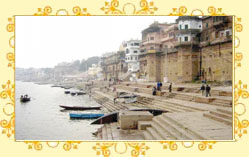
A boat ride on a private hand rowing boat from Dasaswamedh ghat early in the morning is the best way to watch the sunrise and life around the ghats. Some of the important ghats which you shall see are Dasaswamedh ghat, kedar ghat harishchandra ghat, manmandir ghat, manikarnika ghat (cremation ghat), panchganga ghat.
Temples of Varanasi
Vishwanath Temple or the golden temple is dedicated to Lord Shiva, the presiding deity of the city. Varanasi is said to be the point at which the first ‘Jyotir lingam’, the fiery pillar of light by which Shiva manifested his supremacy over other gods, broke through the earth’s crust and feared the heavens. And even the gaga, the Shilling installed in the temple remains the devotional focus of Varanasi. Close by is also the Alamgir Mosque which is blend of Hindu and Muslim type of Architecture. Some say that the mosque was constructed by destroying the original Vishwanath temple and the present temple was constructed by Queen Ahilya Bai. Adjacent to the Golden temple is the temple of Annapurna Bhavani is dedicated to the supreme shanty(She , the being of Plenteous of food) the queen and divine mother of the three world. As the provider of substance she carries a cooking pot rather than the fearsome weapons borne by her horric forms of Durga or Kali.
The other important temples are the New Vishwanath temple at the Banaras Hindu University Campus dedicated to Shiva. Sankat Mochan Temple dedicated to hanuman is in the southern part of the city. Sankat Mochan means the one who removes the suffering, The temple was founded by Goswami Tulsi Das the author of the Hindu epic Ramayana. Tulsi manas temple constructed of white marble is another famous temple of Varanasi it is dedicated to Lord Rama .It was constructed in the year 1964 at the same spot where goswami Tulsidas wrote the famous Ramacharitmanas. Durga Temple or the monkey temple (due to presence of monkey) is dedicated to goddess Durga – wife of Shiva and the Goddess of power. It was constructed in the 18th Century and is said that goddess appeared in the temple of her own (i.e. it was not made by any individual).
Bharat mata Temple or the mother India Temple is dedicated to mother India and is situated in the university Campus of Mahatma Gandhi Kashi Vidyapeeth. There is no statue inside the temple but a relief map of Undivided India carved from a single piece of marble. Temple represents unity in diversity.
Kal Bhairav Temple is another ancient temple of Varanasi and is supposed to be the kotwal of Varanasi. It is believed that without the permission of Kal bhairav no one can stay in Varanasi.
Sarnath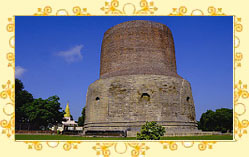
Sarnath is approx 10 kms from Varanasi; it is the place where Buddha preached his first sermons at the sight Dhameek Stupa. There is also the mahabodhi temple and several monasteries. Sarnath museum (closed on Friday) is worth watching it houses several antique stone pieces/heads of Buddha. Our national emblem (the lion head) comes from this museum.
Bharat Kala Bhavan – Art Gallery & Banaras Hindu University.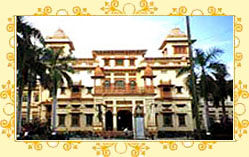
Bharat Kala Bhavan is situated inside Banaras Hindu University. It is an art and Architecture museum and houses some of the finest miniature paintings, Hindu and Buddhist sculptures and materials of archeological importance. It was established in the year 1920. BHU is one of the largest residential universities of the world. It was founded by Mahamana Madan Mohan Malvia. The university imparts education in all fields of education and has contributed in a great deal in the growth of the nation.
Ramnagar fort
The Ramnagar fort is approx 14 km. from Varanasi and is situated on the opposite bank of river Ganges. It is the ancestral home of the Maharaja of Banaras and was built by Maharaja Balwant Singh in the eighteenth century. The fort is built in red sandstone.The Ramnagar fort has a temple and 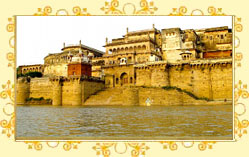 a museum within the grounds. The temple is dedicated to Ved Vyasa, who wrote the great Indian epic Mahabharata. The fort houses a museum displaying the Royal collection which includes vintage Cars, Royal palkies, an armory of swords and old guns, ivory work and antique clocks. An interesting array of ornate palanquins, gold-plated howdahs and weapons are some of the artifacts on display in the Ramnagar fort-palace museum.
a museum within the grounds. The temple is dedicated to Ved Vyasa, who wrote the great Indian epic Mahabharata. The fort houses a museum displaying the Royal collection which includes vintage Cars, Royal palkies, an armory of swords and old guns, ivory work and antique clocks. An interesting array of ornate palanquins, gold-plated howdahs and weapons are some of the artifacts on display in the Ramnagar fort-palace museum.
There is also a Durga Temple and Chhinnamastika Temple and a temple of Dakshin Mukhi Hanuman. The most interesting is that inside the giant walls of the Ramnagar fort-palace, there is a big clock. This clock not only displays year, month, week and day but also astronomical facts about the sun, moon and constellation of stars.
Ganga Aarti
Ganga Aarti (ritual of prayer) at Dasaswamedh ghat. Aarti is a Hindu ritual, in which light from wicks soaked in ghee (purified butter) or camphor is offered and 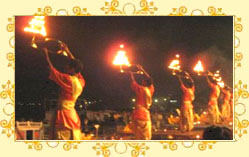 traditional Hindu devotional song is sung during the ritual. This is particularly interesting to see in Varanasi where elaborate Ganga Aarti at Dasaswamedh ghat is held every evening, just after sunset. As the aarti begins, young priests take their positions at the platform and begin swinging the lamp to the tune of chants.
traditional Hindu devotional song is sung during the ritual. This is particularly interesting to see in Varanasi where elaborate Ganga Aarti at Dasaswamedh ghat is held every evening, just after sunset. As the aarti begins, young priests take their positions at the platform and begin swinging the lamp to the tune of chants.
Incenses are burnt, hundreds of floating candles, flowers, and food are released into the Ganges Dasaswamedh ghat becomes a hub of activity, with people sitting and waiting for the aarti, buying flowers and other things from nearby shops or performing pooja.









